Hoa Lo prison is the unique war museum of Hanoi to keep part of the memory of two wars in Vietnam, French colonial time and Vietnam – US War. This place itself was a prison but it is now displayed as a unique museum, where you can find many war evidence that happened in Hanoi, Vietnam.
Hoa Lo prison – Maison Centrale
Located in the downtown of Hanoi, between Hanoi Old Quarter and Hanoi French Quarter, Hoa Lo prison was built by the French administration in 1896. This prison was used to hold political prisoners during colonial times and later to hold the US pilot in the Vietnam War by the Democratic Republic of Vietnam. Visit Hoa Lo prison, you can get both understanding of the French colonial era and the Vietnam War.
Display of The French colonial era, the prison was named Maison Centrale, which the original sign still hangs over the entrance, to hold Vietnamese prisoners, mostly political prisoners.
The exhibitions of this area mostly include an array of shackles, whips and tiny solitary confinement dated back to French colonial periods, even a killing machine stored in the center of the prison. The display also shows the struggle of Vietnam for independence from France.
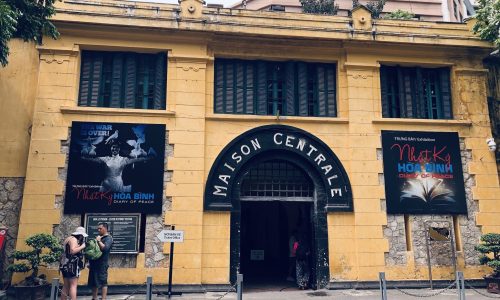
History of Hoa Lo Prison: A Symbol of Struggle and Resilience
Hoa Lo Prison, also known as the “Hanoi Hilton” by American prisoners of war during the Vietnam War, is a complex and impactful site. Its walls have witnessed struggle, suffering, and even moments of surprising resistance.
The prison was built by the French in 1896 to hold Vietnamese political prisoners fighting for independence. It was designed as a panopticon prison, allowing constant surveillance from a central tower. Hoa Lo Prison witnessed numerous escapes, including a daring tunnel breakout in 1945. It also housed prominent Vietnamese revolutionaries like Ho Chi Minh and Vo Nguyen Giap.
During the Vietnam War, Hoa Lo Prison was used by the North Vietnamese to hold American POWs captured during the conflict. American prisoners endured harsh conditions, including torture and solitary confinement. The prison became a symbol of American struggle and resilience, with figures like John McCain emerging as prominent voices. Hoa Lo Prison also witnessed protests and resistance from inmates, including hunger strikes and escape attempts.
After the war, Hoa Lo Prison continued to house Vietnamese dissidents and other political prisoners. It gradually closed in the early 1990s with most of the structure demolished for development. The gatehouse was preserved as a historical museum, which opened in 1993.
Hoa Lo Prison stands as a stark reminder of the horrors of war and political oppression. While depicting the hardships endured by prisoners, it also showcases their unwavering spirit and acts of resistance. The museum stands as a crucial site for understanding the complex history of Vietnam and the lingering impact of conflict.
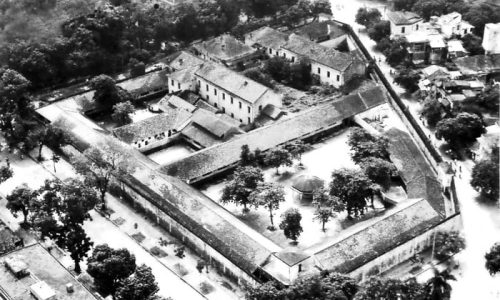
Representative artifacts in Hoa Lo prison – Hanoi Hilton
Hoa Lo Prison, nicknamed the “Hanoi Hilton” by American POWs during the Vietnam War, is more than just a grim reminder of conflict. Beyond the imposing walls and stark cells lie artifacts – silent witnesses to the struggles, resilience, and even moments of hope within its confines. Today, we explore some of these artifacts and the stories they whisper:
1. The Guillotine:
A chilling symbol of oppression, the guillotine stands near the prison entrance, reminding visitors of the harsh justice meted out during the French colonial era. This gruesome instrument claimed the lives of Vietnamese revolutionaries and served as a brutal warning to those fighting for independence.
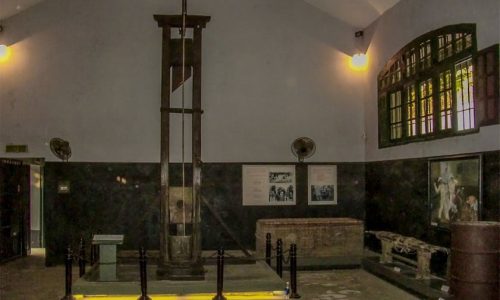
2. Leg Shackles:
These heavy iron shackles, displayed in various cells, are a tangible reminder of the physical constraints endured by prisoners. Used both by the French and the North Vietnamese, they represent the struggle for freedom of movement and the yearning for liberty that echoed within the prison walls.
3. Cages:
In the “cachot,” a dark and dank underground dungeon, cages like these were used to punish prisoners who violated prison rules. Confined in these cramped spaces, often damp and insect-infested, they endured additional physical and psychological suffering.
5. Artwork and Personal Belongings:
Throughout the museum, paintings, drawings, and carvings created by prisoners offer glimpses into their inner lives and emotions. Alongside these poignant expressions, personal belongings like letters, photographs, and religious items paint a more intimate picture of the individuals who inhabited this harsh environment.
These are just a few of the many artifacts that speak volumes at Hoa Lo Prison. Each object holds a story of individual experiences, collective struggles, and the unyielding human spirit that transcends the walls of any prison. As you explore the museum and encounter these silent witnesses, let their stories resonate within you, prompting reflection on the human cost of conflict and the timeless value of freedom.
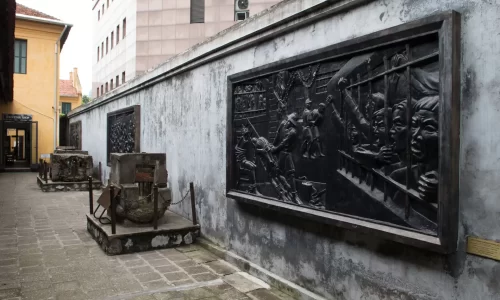
>>> Read more about the top museum in Hanoi
Hoa Lo Prison location, entrance fee and opening hours
- Address: 01, Hoa Lo Street, Hanoi (in the middle of Hanoi Old Quarter and Hanoi French Quarter) View on map
- Opening hours: 08:00 AM – 17:00 PM every day
- Entrance fee: 30.000 VND (1.3 US$)
- Free motorbike parking
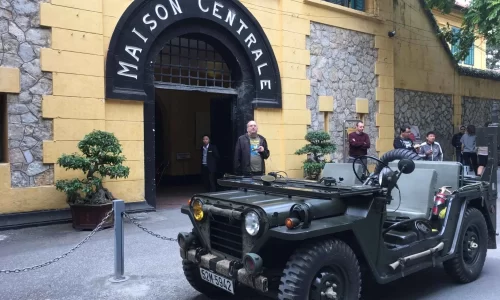
Hoa Lo special events
“Đêm thiêng liêng” or Sacred Night at Hoa Lo Prison
Sacred Night at Hoa Lo Prison is a special program that takes place at the Hoa Lo Prison Relic Museum in Hanoi, Vietnam. The program commemorates the sacrifices of Vietnamese patriots who were imprisoned at Hoa Lo during the French colonial era and the Vietnam War.
The program begins with a candlelight procession through the prison grounds. The procession is led by a group of Vietnamese veterans who were once imprisoned at Hoa Lo. As the procession moves through the prison, the participants stop at various locations to pay their respects to the prisoners who suffered and died at Hoa Lo.
At the end of the procession, the participants gather in the prison’s courtyard for a ceremony. The ceremony includes speeches, music, and poetry readings. The speeches focus on the importance of remembering the sacrifices of Vietnamese patriots. The music and poetry readings are often performed by Vietnamese veterans who were once imprisoned at Hoa Lo.
Sacred Night is a moving and powerful event that honors the memory of Vietnamese patriots who fought for their country’s independence. The program is a reminder of the sacrifices that were made to achieve Vietnamese freedom.
Information
- Location: Hoa Lo Prison Relic Museum, 1 Hoa Lo Street, Hanoi, Vietnam
- Audience: This program is suitable for children over 10 years old, as well as young adults, seniors, and veterans.
- Schedule: Sacred Night is typically held a few times a year on significant occasions or commemorative anniversaries.
- Tickets: Tickets are available online and at the museum.
- Prices:
- Night 1: “Sáng ngời tinh thần Việt” (Shining Vietnamese Spirit), VND 399,000
- Night 2: “Sống như những đóa hoa” (Living Like Flowers), VND 399,000
- Night 3: “Lửa thanh xuân” (Fire of Youth), VND 499,000
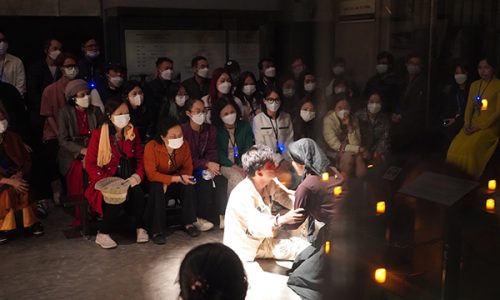
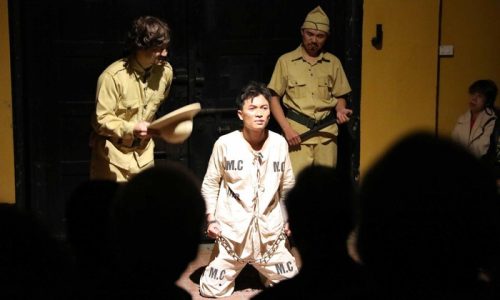
Tips:
- If you are staying in Hanoi for a long time, you may want to consider seeing all three shows of Sacred Night at Hoa Lo Prison. This will allow you to experience the full scope of the program and gain a deeper understanding of Vietnamese history and culture.
- If you are interested in learning more about the history of Hoa Lo Prison, you can visit the museum before or after the show. The museum has exhibits that tell the story of the prison and its prisoners.
Notes visiting Hoa Lo prison
- While there’s no strict dress code, opt for clothing that covers your shoulders and knees. Revealing outfits like tank tops, short shorts, or ripped jeans might be considered disrespectful in this sensitive location.
- Hoa Lo Prison holds a somber history, housing Vietnamese patriots imprisoned during French colonialism and the Vietnam War. Maintain a respectful demeanor and avoid loud behavior, laughing, or joking in inappropriate areas.
- Photography is allowed in most areas, but use flash sparingly to preserve artifacts.
- Listen to guides and signage: Pay attention to instructions from museum staff and information provided on exhibits. This will ensure you gain accurate knowledge while showing respect for the site and its history.
